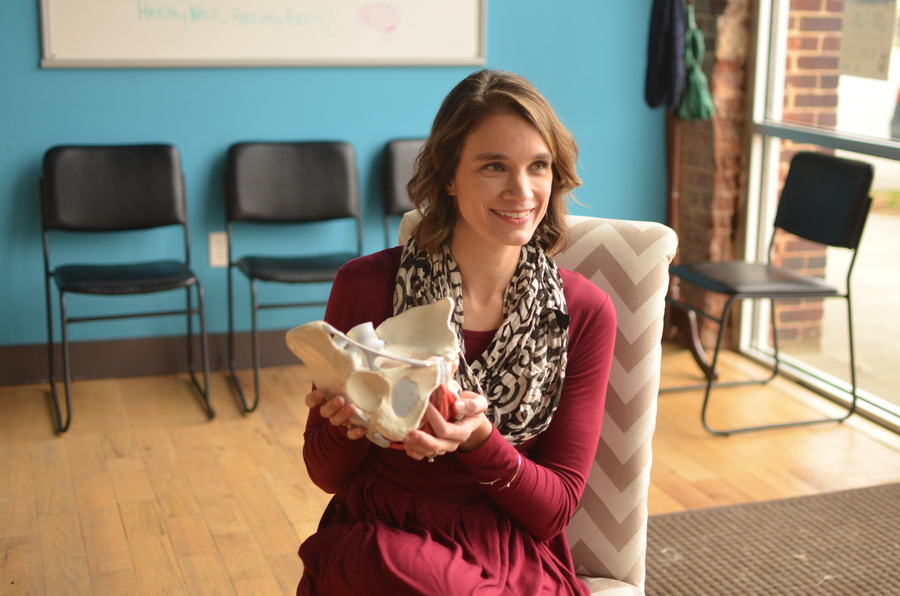Managing Pelvic Floor Dysfunction
Posted in Pelvic Floor Therapy Chattanooga on Nov 05, 2019

Original piece by Health Scope Magazine
Pelvic Floor Dysfunction: What Is It?
The group of muscles that supports a woman’s pelvic organs– the bladder, rectum, and uterus– is known as the pelvic floor. All of these muscles work together with relaxing and contracting movements to help control bladder and bowel functions. When those muscles either underperform or overperform, you can experience a condition referred to as pelvic floor dysfunction. Symptoms vary from patient to patient, but you may experience urine leaking when you cough, sneeze, laugh, or run, and you may have an increased urge to urinate, pain with urination, discomfort with intercourse, and other manifestations of pelvic pain.
What Causes Pelvic Floor Dysfunction?
Though pinpointing the exact causes of pelvic floor dysfunction can be difficult, certain causes or triggers are more common. Injuries to the pelvic area can certain lead to muscle spasms and problems, as can pregnancy and, of course, childbirth. High amounts of stress can also lead to pelvic floor health issues, and in many scenarios, individuals suffer from the effects of pelvic floor dysfunction for years before they even realize what’s going on.
Treatments for Pelvic Floor Dysfunction
For best results in treating the symptoms of pelvic floor dysfunction, a combination of techniques should be performed by a trained physical therapist.
Instrument Assisted Soft Tissue Mobilization (IASTM): This method of treatment is helpful for addressing tight pelvic muscles during and just after pregnancy or following a C-section delivery. Through this method, your clinician will use a set of handheld instruments to help break down scar tissue while releasing strain.
Trigger Point Dry Needling: In this form of treatment, a small needle is used to penetrate the skin and stimulate the underlying trigger point as well as connective tissues. The idea is that, once inserted, the needle will cause a local twitch response, relaxing and changing the muscle fiber length and releasing the contraction of the muscle.
Relaxation/Downtraining: In this method of treatment, the patient will focus on retraining the body to relax through the introduction of deep breathing techniques. These techniques can help your body leave that constant state of “fight or flight,” while helping lengthen the muscles that make up the pelvic floor.
Biofeedback: Designed to help patients rebuild voluntary muscle control, the biofeedback tactic is painless and non-surgical, utilizing special sensors to monitor a patient’s pelvic floor muscles. These sensors are connected to special software that provides both visual and auditory feedback to the therapist that can help inform further treatment plans.
Meagan Moyers, a pelvic floor health expert and the physical therapist behind Resilience Physical Therapy in Chattanooga, sheds light on the subject. “Pelvic floor physical therapy is much more than ‘just doing Kegels.’ or what is commonly thought of as lifting or strengthening the pelvic floor. While this is important in some cases, in some conditions, Kegels may actually make symptoms worse,” she said. “Sometimes the muscles that make up the pelvic floor need to lengthen or relax. Continuing to tighten or contract a muscle that is already hypertonic or in spasm will exacerbate pain and may increase symptoms such as urinary urgency, frequency, or pain with intercourse. Working with a trained pelvic floor physical therapist, who can perform evaluations both externally and internally, will set you on an appropriate course of treatment specific to your needs.”
Moyers is the owner and operator of Resilience Physical Therapy, a Chattanooga TN practice fully dedicated to physical therapy for women’s pelvic health.
SOURCE: https://www.healthscopemag.com/health-scope/managing-pelvic-floor-dysfunction/